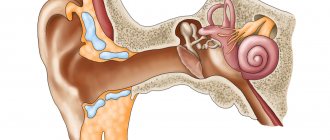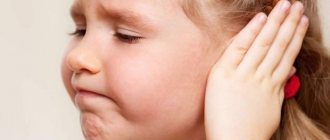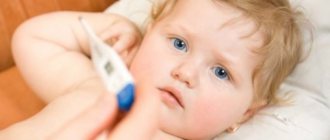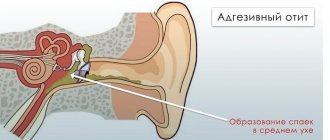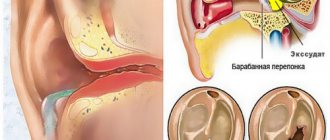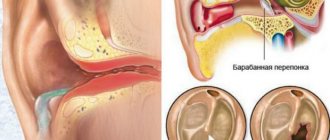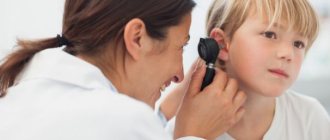Causes
The main factor provoking pathology is a violation of air circulation in the Eustachian tube. At the moment of swallowing, the velum palatine normally rises, equalizing the pressure in the middle ear.
The main cause of the development of acute serous otitis media in children and adults is long-term disruption of air exchange. This usually occurs in patients suffering from sinusitis or adenoiditis. Statistics show that these people have an anatomical narrowing of the nasal passages.
Symptoms of serous otitis
An inflammatory process such as otitis media can have several forms of course and manifestations. In the case when serous fluid accumulates in the ear cavity, but no signs of an acute inflammatory process occur, specialists diagnose serous otitis media. In other words, serous otitis is a mild inflammatory process.
With serous otitis, exudate accumulates in the ear cavity - a serous fluid that is non-purulent in nature. Pathogenic secretions accumulate in the tympanic cavity.
Acute serous otitis media in children and adults can be recognized by the following signs:
- feeling of stuffiness in the ear;
- hearing loss;
- feeling of pressure.
The ear often feels full when swallowing, and otalgia may develop.
However, these symptoms are often not enough for an accurate diagnosis, because such manifestations usually indicate other types of otitis media. To determine the correct diagnosis, otolaryngologists examine the eardrum. With the development of serous otitis, a yellowish or grayish color is noted. Tympanometry is often used to confirm the development of the inflammatory process.
Older children and adults complain of ear pain and hearing loss. At an early stage of the disease, the tympanic membrane swells and, as a result, partially loses its mobility. At a later stage of serous otitis, the membrane retracts, becomes thickened, loses its previous color, and often a specialist may notice white spots on it during examination. In addition, with tympanometry, the otolaryngologist behind the membrane can see the fluid level and air bubbles, and he notes that the light reflex is impaired or completely absent.
Symptoms
Acute serous otitis media differs in its symptoms from other forms of ear diseases. Symptoms of a bacterial infection include severe pain and high fever. With the pathology under consideration, the accumulation of exudate for a long time can occur without any obvious signs.
Among the signs are:
- Feeling of fullness and noise in the ears.
- Hearing impairment.
- When tilting the head, the patient feels temporary relief (congestion subsides, hearing improves). At the same time, the person seems to hear the squelching of liquid.
It is worth noting that such signs are easy to miss when pathology develops in early childhood. Although adult patients most often seek help after a bacterial infection has occurred, causing severe pain.
Otitis media: treatment in children
Infectious diseases require professional treatment; do not try to treat children yourself.
For the treatment of otitis media, the following are usually used:
- Antibiotics. They should always be taken for the period of time prescribed by the doctor. When taking antibiotics, in order to avoid re-infection, it is necessary to strictly follow the entire course of treatment - usually it lasts 5 - 10 days. Decongestants usually do not have a beneficial effect.
- Ear drops. For example, Otipax, it has anti-inflammatory and analgesic effects.
- Children's antipyretics and pain relievers.
- Warming the ear with a heating pad, electric or water, and a warm compress. Soak a cotton swab in boric alcohol, squeeze it out a little, and place it in the ear canal. You can use any of these methods while you wait for the doctor.
- Myringotomy is a surgical procedure that removes infected fluid from the ear through a small incision in the eardrum. The incision heals in about 10 days, but special care is required during this period. Laser myringotomy is a new technology in which the doctor makes a very small incision in the eardrum using a laser.
- Drainage is the insertion of a thin tube to remove residual fluid when a chronic infection cannot be treated with antibiotics. This operation is performed under general anesthesia and is a last resort in cases where other treatments have failed. Typically, a tube is used when fluid has remained in one ear for six months and in both ears for four. The tube falls out after 6–8 months, sometimes earlier.
- Regular examination until the condition of the ears returns to normal, so that the disease does not become chronic.
- Elimination of allergens or treatment of allergies, if allergies lead to otitis media in children.
- Drink plenty of fluids in case of high fever. If the doctor has prescribed antibiotics, your child should be given whole milk yogurt with live cultures to prevent gastrointestinal upset.
Stages
There are 4 stages of serous otitis media. Each of them has its own clinical picture. Let's look at the dynamics of the disease:
- Catarrhal stage, or eustacheitis. During this period, there is a violation of the ventilation of the pipe, inflammation of its mucous membrane. The increase in vacuum in the cavity is provoked by the suction of air through the narrowed hole. Because of this, transudate appears, and lymphocytes and leukocytes migrate in small numbers. At this stage, the disease manifests itself as mild congestion and a slight decrease in the perception of sounds. Eustacheitis can last up to 30 days.
- Secretory stage , during which mucus accumulates in the cavity. It manifests itself as a feeling of pressure, noise, and more pronounced hearing loss. Among the symptoms, there is also a sensation of fluid splashes when changing the position of the head. The duration of development of stage 2 ranges from 1–12 months.
- The mucous stage is characterized by thickening of the fluid accumulated in the tympanic cavity. Bursts when changing the position of the head disappear, and hearing loss increases. The duration of the development stage is from 1 to 2 years.
- The last stage is called “fibrous” . During this period, degenerative changes in the mucous tissues of the tympanum predominate. The production of mucus stops, and the process of fibrous transformation of the membrane begins. The auditory ossicles also undergo pathological changes. Then adhesive otitis media of the middle ear develops.
If you notice even minor discomfort or the manifestation of the listed signs of otitis media, it is important to seek help.
Signs of the disease
Depending on the stage of the disease, the symptoms have a different clinical picture.
Stage 1
Inflammatory lesion of the auditory tube, which stops the flow of air into the middle ear cavity. The eardrum changes color (gray) and appears retracted. The patient experiences periodic slight deterioration in hearing. The catarrhal stage can last up to 1 month.
Stage 2
It is characterized by an increase in serous secretion, and fluid begins to accumulate in the tympanic cavity. The mucous membrane swells. The eardrum becomes bluish or brown. The patient has symptoms of hearing loss and painful pressure in the ear. When the position of the head changes, a splash of liquid is felt in the ear cavity. The secretory period can last up to 12 months.
Stage 3
The disease becomes acute. The liquid becomes thicker, and when taken for analysis, it can stretch several centimeters behind the instrument. Hearing loss is noticeably increasing. The eardrum thickens and swells. There is no sensation of transfusion in the ear, since the serous secretion becomes excessively viscous.
Stage 4
Irreversible processes occur in the mucous membranes, during which the fluid supply is transformed and bone tissue begins to collapse. At this stage, complete hearing loss is possible, which can only be restored through surgery.
It is difficult to detect otitis media in children at an early stage. Symptoms are manifested by an increase in body temperature, purulent fluid begins to ooze out. The baby becomes lethargic, capricious, and often rubs his ear with his palm.
Diagnostics
To determine the pathology, the doctor examines the patient’s hearing organs, nose and throat. Hardware testing helps determine the diagnosis and severity:
- Audiometry is a procedure that allows you to determine hearing acuity and sensitivity to frequency sound waves. The study is carried out by an audiologist, during which an audiogram is obtained. Based on these data, the otolaryngologist determines the degree of hearing loss.
- Tympanometry is a quick and painless way to determine the mobility of the eardrum and the presence of exudate behind it.
Based on the data obtained, the doctor makes a diagnosis and prescribes a treatment regimen.
Therapy in children
You cannot treat middle ear pathology on your own; a doctor must select medications. In children, the treatment regimen is as follows:
- Antibacterial therapy is relevant for bacterial etiology of the disease (Amoxicillin, Cefazolin, Augmentin). Most often, drugs in this group treat acute serous otitis media or chronic inflammation of the hearing organs caused by pathological microflora.
- Anti-inflammatory drugs (Miramidez, Erespal).
- A complex of vitamins and microelements that supports the body during illness.
- The use of nasal vasoconstrictor drops helps restore ventilation in the Eustachian tube (Nazivin, Naphthyzin).
- In some cases, the use of mucolytics is relevant. The drugs help activate the process of liquefying mucus (Sinupret, Ambroxol, ACC).
- Antibacterial drugs in the form of drops (Neladex, Cipropharm). Local application of the drug allows you to destroy pathogenic microflora.
It is worth noting that the acute form of otitis media can be treated without the use of antibiotics. Depending on the intensity of mucus accumulation, the doctor draws up a treatment regimen for each child individually.
Causes of serous otitis media
Among the reasons causing the development of this pathology, experts name the following factors:
- dysfunction of the Eustachian tube;
- penetration of viruses;
- exposure to bacteria;
- action of viruses and bacteria simultaneously.
Even the shortest dysfunction of the Eustachian tube in most cases causes the development of the initial stage of serous otitis in children. This connecting organ performs functions such as ventilation, protection, and drainage. That is why the development of otitis media largely depends on the condition of the auditory tube. The small and short Eustachian tube, as well as its almost horizontal position, lead to frequent relapses of otitis media in children.
Children attending preschool or school educational institutions come into contact with a large number of people, so they are susceptible to frequent respiratory viral infectious diseases. It is known that colds provoke the development of serous otitis, especially with a prolonged runny nose.
Another common factor affecting the condition of a child’s hearing organ is allergic respiratory diseases. As medical practice shows, otitis media most often develops in children suffering from year-round or seasonal allergic rhinitis. Also, do not rule out a food allergy; in children under two years of age, such a reaction most often occurs to milk.
Treatment in adults
Drug treatment is the same as in childhood. The only difference is that the doctor selects medications according to the patient’s age. In addition to the conservative method, the following procedures may be prescribed:
- Eardrum massage.
- Phono- or electrophoresis.
- Laser therapy is effective for ear inflammation.
- Blowing using the Politzer method.
Treatment of serous otitis in both adults and children in an advanced stage often requires surgical intervention:
- Myringotomy.
- Tympanopuncture.
Both procedures involve perforating the eardrum. They are quite painful, so they are performed in a hospital setting under anesthesia. Adenotomy is also prescribed if necessary.
Serous otitis in children
otorhinolaryngologist, doctor of the highest category
Serous otitis is an inflammatory process that occurs in the middle ear, behind the eardrum. Fluid accumulates in the tympanic cavity. This is the so-called initial otitis, which can later develop into purulent otitis. Pus can escape through the eardrum, and the next stage of the disease will develop.
Serous otitis is one of the most common ENT pathologies in children. Most often it occurs in preschool age - up to 6-7 years.
Reasons for the development of the disease
the cause of the development of serous otitis is a runny nose, which can be associated both with the presence of a viral infection and with adenoids (in children).
Since the hearing organs are directly connected to the nasopharynx, the Eustachian tube (which connects the cavity of the middle ear to the pharynx) with a runny nose can become overfilled with mucous secretions and stop performing its functions.
In this case, the fluid accumulates in the middle ear cavity, cannot leave naturally and becomes a cause of inflammation.
Another reason is pathology of the eustachian tube itself. Disturbances in the passage of air in the Eustachian tube are often accompanied by the development and proliferation of pathogenic microflora.
Signs of serous otitis
Stuffiness or pain in the ear.
Serous otitis in children develops quite acutely and quickly. This usually happens at night, the child cries and points to the sore ear. Such symptoms are a reason to immediately contact a pediatrician or otolaryngologist.
Can I start using ear drops on my own?
If a child has an earache and nothing comes out of it, drops with an analgesic and anesthetic effect can be instilled. But it is better to show the child to the doctor as soon as possible. If necessary, you can give painkillers - Ibuprofen or Paracetamol.
What not to do with serous otitis
With serous otitis, you should not warm the ear (with blue lamps, boiled eggs, etc.), or make compresses. Warming up can be effective only at the initial stage, up to 1 day, but it is extremely rare to “catch” this stage.
Diagnostics
Serous otitis media can be diagnosed by a general practitioner, pediatrician, or otolaryngologist during examination using otoscopy.
ENT doctors perform tympanometry - measuring the pressure behind the eardrum. The patient hears a certain sound in the ear, and the doctor receives information about the presence of fluid in the middle ear cavity and its nature, if any. Most often this test is used in children. In adults, fluid is often visible upon visual examination.
Treatment of serous otitis in children and adults
In children, the development of the disease occurs very quickly, so if a child experiences pain in the ear, be sure to immediately show it to a doctor - a pediatrician or otolaryngologist.
Children under 1 year of age with serous otitis must be prescribed antibacterial therapy (antibiotics), regardless of whether there is intoxication, high fever, or abnormalities in the clinical blood test. This is due to the peculiarities of the child’s anatomy, the speed of the inflammatory process, which can move to another stage within an hour.
Otitis in adults does not always require treatment with antibiotics. Serous (catarrhal) otitis media in adults can be treated with ear and nasal drops. During the period of illness, flights are not recommended due to pressure changes, which can negatively affect the condition of the eardrum.
Depending on the stage of otitis and the age of the patient, treatment can be conservative (medicinal) and surgical.
Drug treatment includes:
treatment of the nasopharynx to relieve the auditory tube, relieve swelling;
sometimes local drops in the ear are prescribed;
if antibacterial therapy is prescribed, ear drops are usually no longer necessary;
you can add gymnastics for the auditory tube, chewing gum, blowing, etc.
If conservative treatment is not effective in a child, namely, intoxication, pain persists, and fluid remains in the ear, surgical treatment is used.
In children, we can observe the presence of fluid and treat it conservatively for 1-1.5 months. During this time, the liquid will not thicken and will not interfere with the movement of the auditory ossicles that are located in the ear.
The operation consists of puncturing the eardrum under a microscope and installing drainage - a shunt or tube. They are silicone and allow fluid to drain out of the middle ear.
The essence of the treatment is to allow air to appear in the ear cavity so that the child does not experience hearing loss. The tubes remain in the ear for varying periods of time - from one month to a year, and even longer.
Sometimes they fall out on their own when the inflammation goes away and ear function is restored. Or we take them out after a while ourselves.
Prevention
To prevent the appearance of serous otitis, you need to pay more attention to the nose. While an adult can talk in detail about his complaints - nasal congestion, problems blowing his nose, a child does not always succeed. Do not rinse children's noses under pressure; use saline solution to rinse and moisten. Children must be taught to blow their nose and use aspirators less.
Doctors and staff
Why do some children get sick often?
Reviews
Amazing doctor. A very sympathetic and kind-hearted person. He knows how to find an approach even to the smallest patients, with whom it is most difficult. A professional in his field. At doctor’s appointments, everything is clear and understandable, and most importantly, calm.
Always prescribes adequate treatment. It is very important to find exactly your pediatrician (more details)
Amazing doctor. A very sympathetic and kind-hearted person. He knows how to find an approach even to the smallest patients, with whom it is most difficult. A professional in his field. At doctor’s appointments, everything is clear and understandable, and most importantly, calm.
Always prescribes adequate treatment. It is very important to find your own pediatrician, whom you will trust unconditionally. Vladislav Sergeevich is exactly like that. We are his regular patients. He repeatedly treated my son for obstructive bronchitis and pneumonia.
For which I am very grateful to him. (Hide)
Questions and answers
The child is 11 years old and has been coughing for more than six months. The cough is dry, sometimes paroxysmal, the child coughs, mainly during the day, at night there is no cough at all. More often (more details)
The child is 11 years old and has been coughing for more than six months. The cough is dry, sometimes paroxysmal, the child coughs, mainly during the day, at night there is no cough at all. Occurs more often before bedtime. UBC tests were normal, glucose 4.
16, allergy IgE total 111.80, toxocara, roundworm negative, cytomegalovirus, mycoplasmosis negative, Mantoux test too. X-ray of the lungs is normal. We have already seen a therapist, an ENT specialist, a pulmonologist, a neurologist, and a gastroenterologist. The cough continues.
What to do? (Hide)
Firstly, the results you described do not reflect the examination of the child for whooping cough. Even if he is vaccinated, the disease cannot be ruled out. You need to take a blood test for antibodies to the causative agent of whooping cough (donate blood (more details)
Firstly, the results you described do not reflect the examination of the child for whooping cough. Even if he is vaccinated, the disease cannot be ruled out. You need to take a blood test for antibodies to the causative agent of whooping cough (donate blood for antibodies of classes M and G to Bordetella pertussis).
Secondly, even a slight increase in class E antibodies is a reason for a visit to an allergist and an assessment of external respiratory function using, if necessary, a drug that eliminates bronchospasm (bronchodilator). This method identifies diseases in which bronchospasm is not obvious.
Even if the results of this examination turn out to be normal, the allergist must exclude the allergic nature of the cough. Thirdly, such a cough may be a consequence of the reflux of acidic contents from the stomach into the esophagus (so-called reflux). Without data on the results of an examination by a gastroenterologist, it is difficult to draw conclusions.
In order to confirm or exclude the presence of reflux, daily monitoring of the acidity of the stomach and esophagus is carried out. Fourthly, you do not write about whether an X-ray examination of the nasopharynx and paranasal sinuses was done. Perhaps, after all, there is a pathology on the part of the ENT organs. (Hide)
Chronic serous otitis media
Chronic serous otitis media is characterized by a painless accumulation of fluid in the tympanic cavity in the absence of inflammation. Infants and young children are more often affected. Chronic serous otitis media is the most common cause of hearing loss in children in the United States. About 30% of children with chronic serous otitis media require allergy examination and allergy treatment.
A. Etiology. Chronic serous otitis media develops due to dysfunction of the auditory tube.
The auditory tube prevents mucus from entering the oropharynx into the tympanic cavity, serves to ventilate the middle ear, equalizes the air pressure on both sides of the eardrum and drains the tympanic cavity.
When the auditory tube expands, its protective function suffers, and secretions from the nasopharynx can enter the tympanic cavity. Violation of the ventilation and drainage functions of the auditory tube is observed with its complete or partial obstruction, which may be due to the following reasons.
1. Anatomical disorders - adenoids, cleft palate, nasopharyngeal tumors, swelling of the mucous membrane and a large amount of discharge in the nasopharynx, caused by an allergic disease or infection.
2. Functional disorders - collapse of the walls of the auditory tube due to decreased elasticity, incomplete opening of the pharyngeal opening of the auditory tube due to dysfunction of the muscle that stretches the soft palate.
These disorders usually occur in infants and young children, so chronic serous otitis media most often develops at this age.
A large number of mucous glands, small diameter and underdevelopment of the cartilage of the auditory tubes also contribute to the disruption of their patency in young children.
3. Allergic diseases. In the presence of predisposing factors (the anatomical and functional disorders listed above), the development of chronic serous otitis media is promoted by allergic rhinitis.
Swelling of the nasal mucosa disrupts the regulation of pressure in the middle ear cavity, as a result of which, when swallowing, the contents of the nasopharynx enter the middle ear under pressure.
The role of allergic reactions in the development of chronic serous otitis media in patients with atopic diseases is confirmed by clinical and laboratory studies.
In the contents of the tympanic cavity, the general level of IgE and the level of specific IgE are increased; when provocative tests are carried out with intranasal administration of allergens, the patency of the auditory tubes is disrupted. During the period of seasonal increases in the concentration of airborne allergens, dysfunction of the auditory tube is detected in approximately a third of children with allergic rhinitis.
B. Pathogenesis. Normally, the tympanic cavity is free of fluid and contains air, the volume of which is regulated by the auditory tube. When the functions of the auditory tube are impaired, secretions accumulate in the tympanic cavity, gradually displacing air.
When an infection occurs, the serous discharge becomes purulent. Chronic infection leads to hyperplasia of the mucous membrane of the tympanic cavity. The nature of the fluid accumulating in the tympanic cavity depends on the stage of the disease.
In the early stages it is usually yellow with a relatively low viscosity; as the disease progresses, it darkens and becomes more viscous.
In later stages, the contents of the tympanic cavity acquire a gray-blue color and become very viscous and sticky, preventing the movement of the auditory ossicles and eardrum.
Source: https://dou99.ru/poleznaya-informatsiya/seroznyj-otit-u-detej
Prevention
Experts recommend following a few simple rules to reduce the likelihood of developing pathology:
- Avoid contact with people if they have the flu or acute respiratory viral infection.
- In winter, wear a warm hat.
- Perform hygiene procedures carefully (avoid injury to the tissue inside the ear).
The pathology of the hearing organ in question is a rather dangerous disease, since its asymptomatic course leads to the loss of precious time. But even if you go to the hospital at a late stage, the doctor’s competent actions lead to the patient’s recovery.
Author: Tatyana Grosova, nurse specially for Moylor.ru
